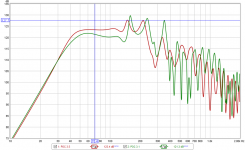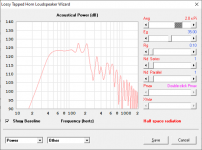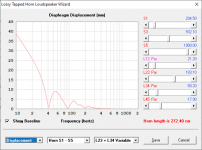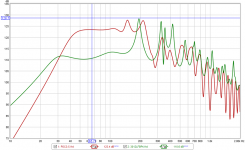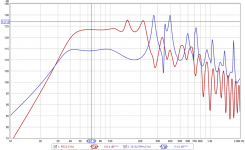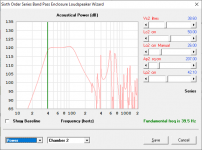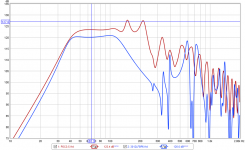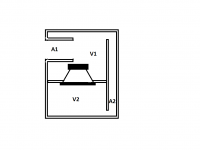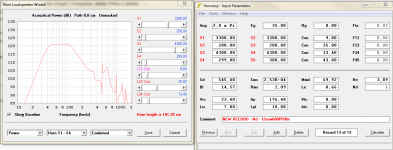I'm trying to determine whether I should build this or not. It's a larger version of my POC3 TH, designed to get the most out of the Eminence Kappalite 2012-LF-4 down to 40 Hz. Net box volume is quite a bit larger than the POC3 (221 l vs 126 l), but there's also an increase in output across the passband. Is it worth it? Hmm...
Attachments
would that be a "3012LF"? - think it would be worthwhile - fwiw here's a Thunderbolt at 0.8 scale with 3012LF-8 (9.1mm Xmax) and similar bulk to POC 3.5TH.
(I'd like to see a Hi-Fi midbass FLH in your POC lineups)
(I'd like to see a Hi-Fi midbass FLH in your POC lineups)
An externally hosted image should be here but it was not working when we last tested it.
I'm trying to determine whether I should build this or not. It's a larger version of my POC3 TH, designed to get the most out of the Eminence Kappalite 2012-LF-4 down to 40 Hz. Net box volume is quite a bit larger than the POC3 (221 l vs 126 l), but there's also an increase in output across the passband. Is it worth it? Hmm...
Depends. What's the cost of another driver?
I'd suggest that, for PA work (which this design appears to head towards), having some redundancy is a benefit.
Chris
would that be a "3012LF"?
Correct - my fumble-fingers were at work last night, it seems.
- think it would be worthwhile - fwiw here's a Thunderbolt at 0.8 scale with 3012LF-8 (9.1mm Xmax) and similar bulk to POC 3.5TH.
I'm using the 4-ohm version of the driver, which has slightly different parameters. The sim I provided shows the response @35V, which has the driver hitting Xmax (9mm) within the passband, and usable output down to 40 Hz. Your design has V at 49V for the 8 ohm driver, and Xmax being greatly exceeded at 40 Hz. This is one of the advantages of 6th order alignments - reduced excursion requirements at the lower end of the effective passband.
(I'd like to see a Hi-Fi midbass FLH in your POC lineups)
Eventually it will happen. Eventually 🙂
Attachments
Whips mine, but it's only ~108 L net, so 'BIB' still rules. 😉
GM
Oops! Posted the wrong one for a ~same-same comparison:
GM
Oops! Posted the wrong one for a ~same-same comparison:
Attachments
Last edited:
Whips mine, but it's only ~108 L net, so 'BIB' still rules. 😉
GM
Oops! Posted the wrong one for a ~same-same comparison:
This is definitely a case of bigger is better, LOL.
But you've given me some ideas. I've been playing around with another possible BP alignment for this driver. Trying to get the most out of one 12" driver will still ending up with a box that can fit in my car's trunk (for transport purposes) is a challenge...
Attachments
Yeah, there's some definite advantages to a bigger cab, especially if it's a TH and why prosound loves them.
GM
GM
This one's not too big, and the 6th order BP alignment controls excursion at low frequencies, and the out of band noise is pushed up high where lining the box might be able to take care of a good portion of it...
The devil's in the details though. How to turn this layout into a box that can be built...
The devil's in the details though. How to turn this layout into a box that can be built...
Attachments
Last edited:
If it's about size, did you tryed parrallel 6th ?
Low range port still need to be well sized for port compression, while high range port output section can be way smaller/less long, or can be replaced with a passive radiator since air displaced is way lower, but it need low mass PR, high qms not to loose too much, but since it's for higher way, using yet a driver with low inductance, you got some margin.
For the lower range port output, you can even use dual back chamber to get even better noise filtering, tweaking resonnance and curve, transforming a bracing in wall to separate both sections, depending on your design. I really like hornresp BPC type arrangement.
Low range port still need to be well sized for port compression, while high range port output section can be way smaller/less long, or can be replaced with a passive radiator since air displaced is way lower, but it need low mass PR, high qms not to loose too much, but since it's for higher way, using yet a driver with low inductance, you got some margin.
For the lower range port output, you can even use dual back chamber to get even better noise filtering, tweaking resonnance and curve, transforming a bracing in wall to separate both sections, depending on your design. I really like hornresp BPC type arrangement.
EDIT repetita :
136 L
Smooth, lower order high pass/low pass (better delay) using polyfill in 1st back chamber.
Don't pay attention to comment in hornresp screen. I used your kappa 12lf4 input parameter without semi-inductance as starting point.
It's the same topology as BPC, but done in ND mode with straight segment mode to be able to use damping.
136 L
Smooth, lower order high pass/low pass (better delay) using polyfill in 1st back chamber.
Don't pay attention to comment in hornresp screen. I used your kappa 12lf4 input parameter without semi-inductance as starting point.
It's the same topology as BPC, but done in ND mode with straight segment mode to be able to use damping.
Attachments
Last edited:
- Home
- Loudspeakers
- Subwoofers
- POC 3.5 TH?

